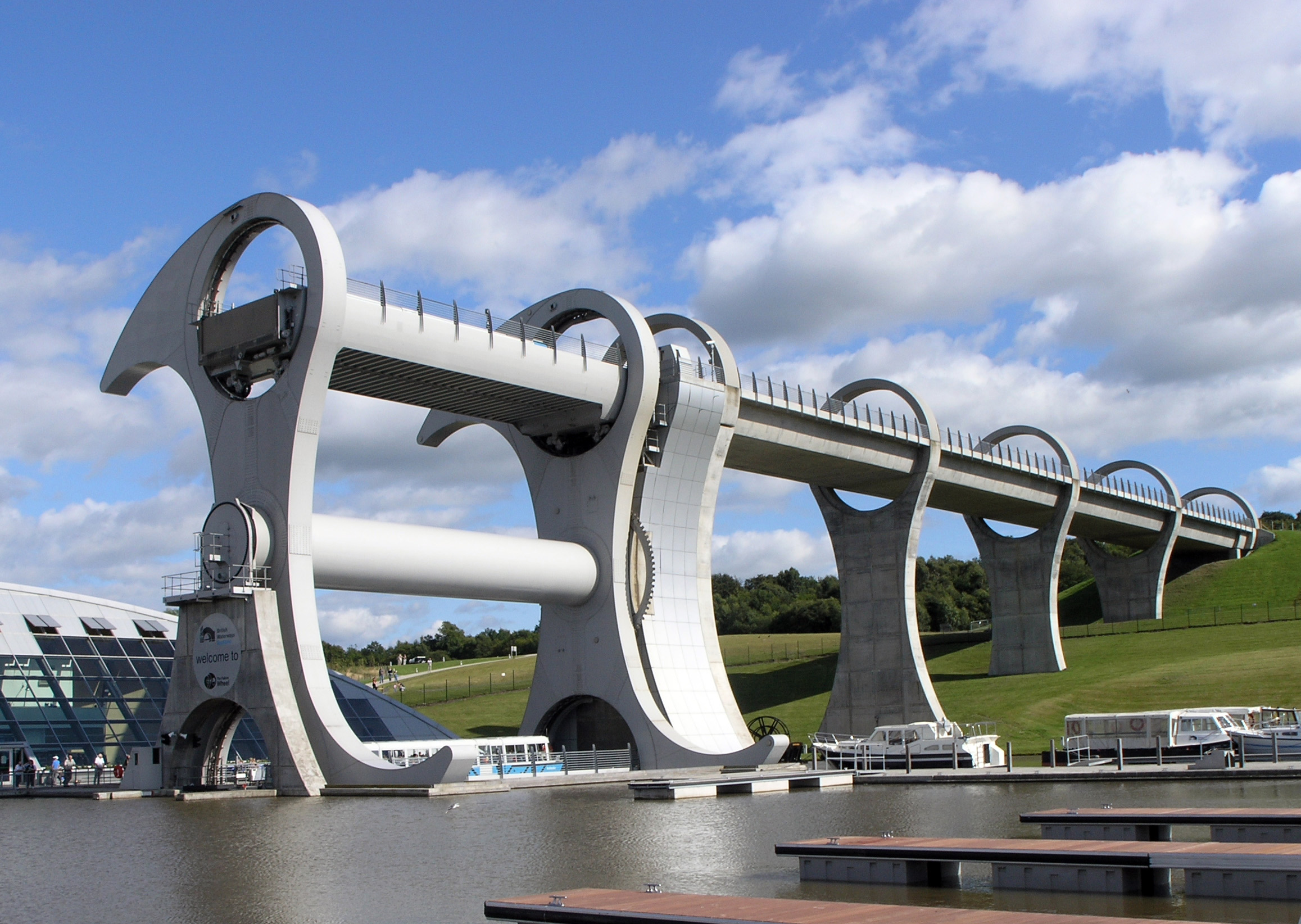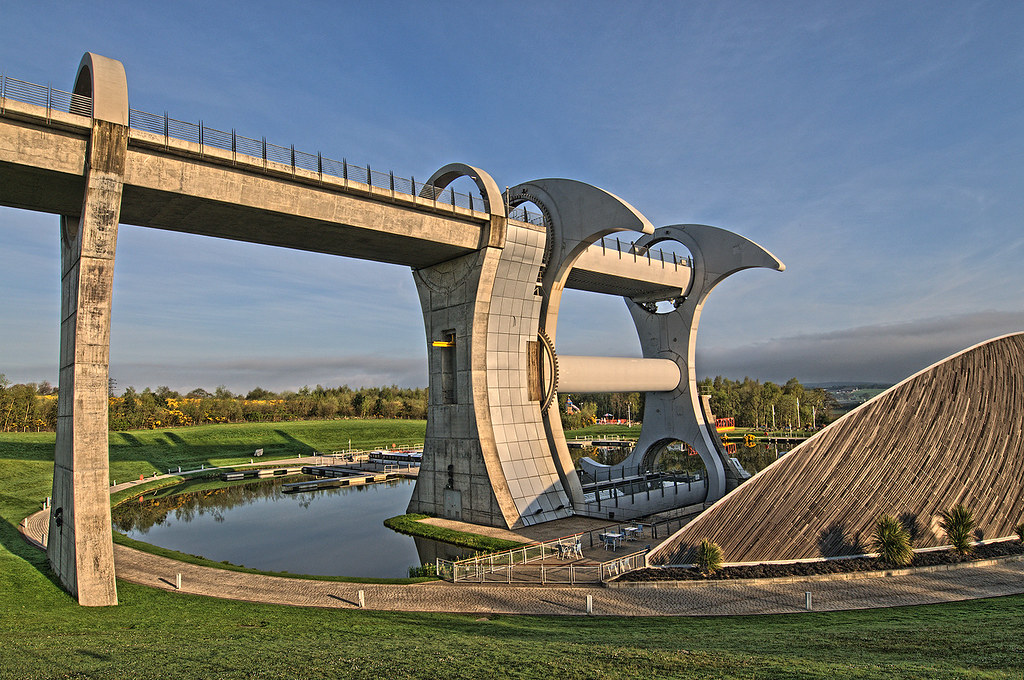Falkirk Wheel
The Falkirk Wheel is a rotating boat lift connecting the Forth and Clyde Canal with the Union Canal. It is named after the nearby town of Falkirk in central Scotland. The difference in the levels of the two canals at the wheel is 24 metres (79 ft).
 Photo by nonmipare
Photo by nonmipareThe original concept of a wheel to act as a boat lift actually dates back to 19th Century Europe, but it was first seriously considered by British Waterways as a solution for Falkirk in 1994. Dundee Architects, Nicoll Russell Studios presented a Ferris Wheel type design that was used to secure Millennium Commission Funding for the Project. This outline design was then reappraised to create a functional lift that could raise and lower boats swiftly whilst celebrating the reconnection of the two historic canals with a structure worthy of a new millennium.Ideas and concepts were numerous, and varied from rolling eggs to tilting tanks, giant see-saw to overhead monorails and included some complex counterbalanced structures. The final outcome was The Falkirk Wheel, which successfully combines both function and design, creating a stunning piece of working sculpture.
The unique shape of the structure is claimed to have been inspired by various sources, both manmade and natural, such as a Celtic double headed spear, a vast turning propeller of a Clydebank built ship, the ribcage of a whale or the spine of a fish. The canal network as a ‘backbone’ connecting Scotland, east to west seems appropriate and there a true beauty in the repetitive sweeping shapes of the aqueduct. The arches over the aqueduct also add to the drama of the structure, forming a complete circle with the reflection in the canal to extend the feeling of the tunnel. The fact the canal literally ends in mid air creates a thrilling sense of sailing off the edge in to the spectacular scenery of the horizon.
The unique shape of the structure is claimed to have been inspired by various sources, both manmade and natural, such as a Celtic double headed spear, a vast turning propeller of a Clydebank built ship, the ribcage of a whale or the spine of a fish. The canal network as a ‘backbone’ connecting Scotland, east to west seems appropriate and there a true beauty in the repetitive sweeping shapes of the aqueduct. The arches over the aqueduct also add to the drama of the structure, forming a complete circle with the reflection in the canal to extend the feeling of the tunnel. The fact the canal literally ends in mid air creates a thrilling sense of sailing off the edge in to the spectacular scenery of the horizon.

The various parts of The Falkirk Wheel were actually constructed and assembled, like one giant Meccano set, at Butterley Engineering’s Steelworks in Derbyshire. A team there carefully assembled the 1,200 tonnes of steel, painstakingly fitting the pieces together to an accuracy of just 10 mm to ensure a perfect final fit.In the summer of 2001, the structure was then dismantled and transported on 35 lorry loads to Falkirk, before all being bolted back together again on the ground, and finally lifted by crane in five large sections into position. The total 600 tonne weight of the water and boat filled gondolas imposes immense and constantly changing stresses on the structure as it turns around the central spine. Normal welded joints of steel would be susceptible to fatigue induced by these stresses, so to make the structure more robust, the steel sections were bolted together. Over 15,000 bolts were matched with 45,000 bolt holes, and each bolt was hand tightened.
The wheel, which has an overall diameter of 35 metres (110 ft), consists of two opposing arms which extend 15 metres beyond the central axle, and which take the shape of a Celtic-inspired, double-headed axe. Two sets of these axe-shaped arms are attached about 25 metres (82 ft) apart to a 3.5 metres (11 ft) diameter axle. Two diametrically opposed water-filled caissons, each with a capacity of 80,000 imperial gallons (360,000 l, 96,000 US gal), are fitted between the ends of the arms.
These caissons always weigh the same whether or not they are carrying their combined capacity of 600 tonnes (590 LT, 660 ST) of floating canal barges as, according to Archimedes' principle, floating objects displace their own weight in water, so when the boat enters, the amount of water leaving the caisson weighs exactly the same as the boat. This keeps the wheel balanced and so, despite its enormous mass, it rotates through 180° in five and a half minutes while using very little power. It takes just 22.5 kilowatts (30.2 hp) to power the electric motors, which consume just 1.5 kilowatt-hours (5.4 MJ) of energy in four minutes, roughly the same as boiling eight kettles of water.
The wheel, which has an overall diameter of 35 metres (110 ft), consists of two opposing arms which extend 15 metres beyond the central axle, and which take the shape of a Celtic-inspired, double-headed axe. Two sets of these axe-shaped arms are attached about 25 metres (82 ft) apart to a 3.5 metres (11 ft) diameter axle. Two diametrically opposed water-filled caissons, each with a capacity of 80,000 imperial gallons (360,000 l, 96,000 US gal), are fitted between the ends of the arms.
These caissons always weigh the same whether or not they are carrying their combined capacity of 600 tonnes (590 LT, 660 ST) of floating canal barges as, according to Archimedes' principle, floating objects displace their own weight in water, so when the boat enters, the amount of water leaving the caisson weighs exactly the same as the boat. This keeps the wheel balanced and so, despite its enormous mass, it rotates through 180° in five and a half minutes while using very little power. It takes just 22.5 kilowatts (30.2 hp) to power the electric motors, which consume just 1.5 kilowatt-hours (5.4 MJ) of energy in four minutes, roughly the same as boiling eight kettles of water.
 Photo by Diamanx
Photo by DiamanxThe wheel is the only rotating boat lift of its kind in the world, and is regarded as an engineering landmark for Scotland. The United Kingdom has one other boat lift: the Anderton boat lift in Cheshire. The Falkirk Wheel is an improvement on the Anderton boat lift and makes use of the same original principle: two balanced tanks, one going up and the other going down, however, the rotational mechanism is entirely unique to the Falkirk Wheel. Since 2007 the Falkirk Wheel has featured on the obverse of the new series of £50 notes issued by the Bank of Scotland. The series of notes commemorates Scottish engineering achivements with illustrations of bridges in Scotland such as the Glenfinnan Viaduct and the Forth Rail Bridge.

The Falkirk Wheel lies at the end of a reinforced concrete aqueduct that connects, via the Roughcastle tunnel and a double staircase lock, to the Union Canal. Boats entering the Wheel’s upper gondola are lowered, along with the water that they float in, to the basin below. At the same time, an equal weight rises up, lifted in the other gondola. This works on the Archimedes principle of displacement. That is, the mass of the boat sailing into the gondola will displace an exactly proportional volume of water so that the final combination of ‘boat plus water’ balances the original total mass.
Each gondola runs on small wheels that fit into a single curved rail fixed on the inner edge of the opening on each arm. In theory, this should be sufficient to ensure that they always remain horizontal, but any friction or sudden movement could cause the gondola to stick or tilt. To ensure that this could never happen and that the water and boats always remain perfectly level throughout the whole cycle, a series of linked cogs acts as a back up.

Hidden at each end, behind the arm nearest the aqueduct, are two 8m diameter cogs to which one end of each gondola is attached. A third, exactly equivalent sized cog is in the centre, attached to the main fixed upright. Two smaller cogs are fitted in the spaces between, with each cog having teeth that fit into the adjacent cog and push against each other, turning around the one fixed central one. The two gondolas, being attached to the outer cogs, will therefore turn at precisely the same speed, but in the opposite direction to the Wheel.
Each gondola runs on small wheels that fit into a single curved rail fixed on the inner edge of the opening on each arm. In theory, this should be sufficient to ensure that they always remain horizontal, but any friction or sudden movement could cause the gondola to stick or tilt. To ensure that this could never happen and that the water and boats always remain perfectly level throughout the whole cycle, a series of linked cogs acts as a back up.

Hidden at each end, behind the arm nearest the aqueduct, are two 8m diameter cogs to which one end of each gondola is attached. A third, exactly equivalent sized cog is in the centre, attached to the main fixed upright. Two smaller cogs are fitted in the spaces between, with each cog having teeth that fit into the adjacent cog and push against each other, turning around the one fixed central one. The two gondolas, being attached to the outer cogs, will therefore turn at precisely the same speed, but in the opposite direction to the Wheel.

Given the precise balancing of the gondolas and this simple but clever system of cogs, a very small amount of energy is actually then required to turn the Wheel. In fact, it is a group of ten hydraulic motors located within the central spine that provide the small amount, just 1.5kw, of electricity to turn it.
The Falkirk Wheel cost £17.5 million, and the restoration project as a whole cost £84.5 million (of which £32 million came from National Lottery funds).
The Falkirk Wheel cost £17.5 million, and the restoration project as a whole cost £84.5 million (of which £32 million came from National Lottery funds).


0 comments:
Post a Comment